The JBL
L26 has been in the attic for some time
and a mail from the US about a possible second round on
the L26 got me started on the final chapter on this
vintage JBL speaker.
From the beginning it was clear that this speaker might
end up as a 3-way. A large 10" bass driver with
problems in the 2 kHz region doesn't exactly call for a
2-way despite the 2-way crossover working reasonably
well. To make a 2-way from a 10" midbass takes a
driver with a very smooth roll-off profile, and this JBL
hasn't.
As discussed before,
restoring old speakers always leaves you with a lot of
dilemmas. What should be left "as-is" and what
should be modified to possibly enhance performance. You
easily get into modifying everything, leaving little of
the original design and end up with a modern speaker made
from highly tweaked old components with little
resemblance of the real thing. The L26 may not be one of
the most precious gems from the JBL company and I have
tried taking the middle road and added bracing to the
cabinet, done only little to the drivers and most
importantly, kept the LE25 for treble. This is really not
a bad tweeter, but it needs some equalisation to deliver
the best. I could very easily have taken the SEAS MCA12
for mid and the 27TFFC tweeter for treble - but then it
definitely wouldn't be a JBL speaker any more.
Having a pair of JBL LE5-12
middrivers, these might be a possible option for a
suitable midrange relieving the bass of handling the
troublesome upper mid/lower treble range, but these LE5
drivers can be major trouble and I almost gave up in the
process. The LE5 drivers are found in a number of
variants and I have a pair of LE5-12 and a pair of LE5-2
(the latter the alnico version from the L100 and other
JBL speakers). The LE5-2 is worse than the LE5-12 but
I'll get back to this later.
The LE5-12 is identical to the LE5-6,
thus this crossover is suitable for JBL L36 DECADE. Here's a list of
LE5- midrange drivers.
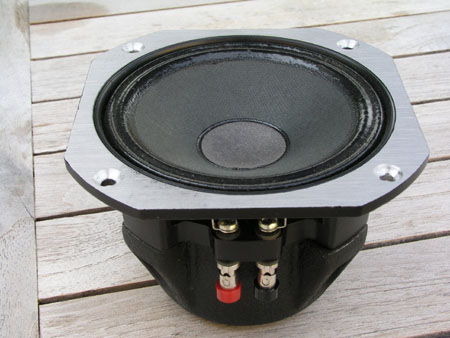 
The
one and only alnico LE5-2 to the left
and the "modern" ceramic magnet version LE5-12
to the right.
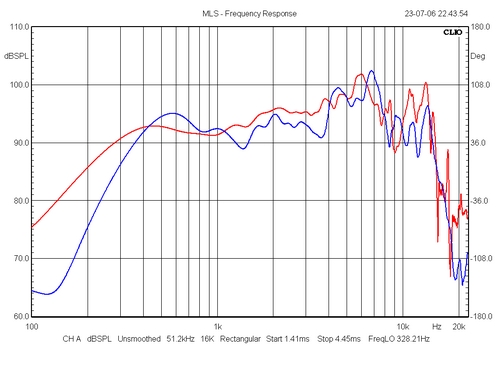 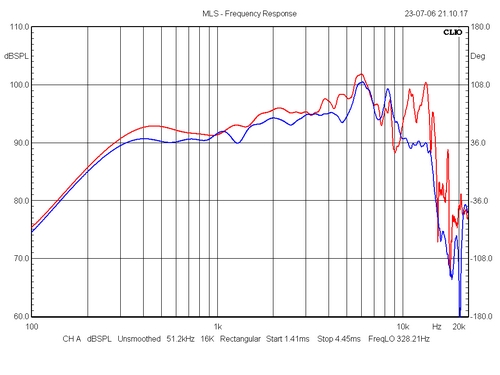
Seen above (left) is the response
of the LE5-2 (blue) and LE5-12 (red) on a 20 cm wide
baffle. Overall sensitivity appear to be almost the same.
The ceramic magnet on the LE5-12 is doing very well and
from this presentation the LE5-12 seems like a much
better driver compared to the LE5-2, having a smooth
response in the upper mid and lower treble.
When I got my LE5-12 drivers, one of them had a severely
bumped alu dome and there's no way you can restore the
very thin alu that forms the dust cap. So off it went and
I added an inverted paper dome like the one on the LE5-2
- and I shouldn't have done that. The frequency response
turned out just as bad as the LE5-2. Hmm.... I really
thought this alu dust cap was crap and then it turns out
to be much better than the paper "bowl" of the
LE5-2. So what to do? I didn't have new alu domes and no
suitable paper domes as well. But I had a pair of rubber
domes from an old pair of Vifa P13WH drivers. A rubber
dome on a JBL driver??
Right: The response of the LE5-12
with alu dome (red) and with rubber dome (blue). This
really doesn't look bad. The driver now has a steadily
rising response up to 6 kHz, a minor peak at 8 kHz and
it's gotten rid of all the rubbish above 10 kHz. The
sensitivity seems a little reduced, but there's plenty
for an L26 3-way.
So in went the rubber dome as seen on the photos below.
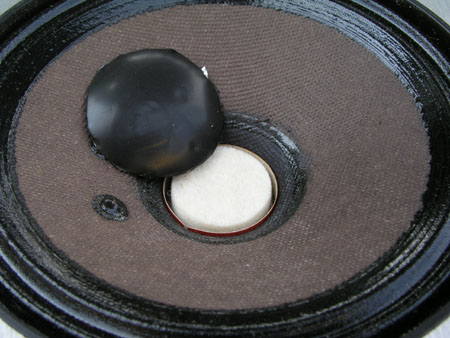 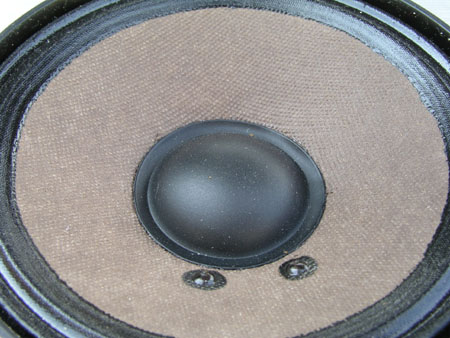
LE5-12 with alu dome
removed to the left (felt material added the
polepiece for damping) - and LE5-12 with rubber
dome to the right.
Should you want to follow this route I have no
idea where you can get two rubber domes, but I'll
try making a crossover version suitable for the
alu dome just in case you have these in good
condition. Even if they have minor bumps I
recommend leaving them in place. I didn't measure
any difference from my bumped and non-bumped
drivers.
So this all looks very nice, but the trouble
doesn't stop here. The LE5-12-RD (rubber dome)
may perform well on a 20 cm baffle, but the L26
cab is much wider.
|
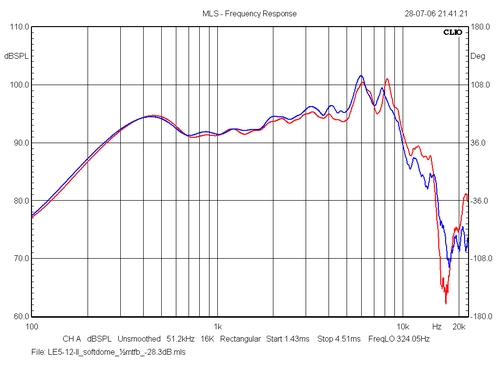 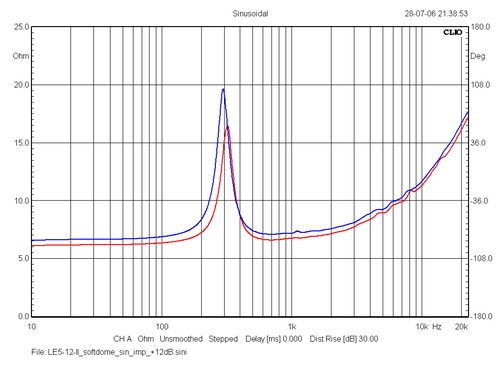
Left: Above the response
of the two LE5-12-RD on the L26 baffle after the rubber
dome glue has settled. Not bad at all.
As soon as the LE5 mids sees a wide baffle, the response
below 800 Hz rises some 4 dB, the LE5-2 even worse than
seen here. One of the reasons for this is the very high
Fs of the drivers as seen below.
Right: Above the
impedance of my two LE5-12-RD drivers in free air. These
LE5 mids really behave more like giant tweeters than
middrivers. They would fit in well with the old
Wharfedale open baffle speaker with its up-firing 3"
"tweeter".
Numerous hours were spend with the LspCAD to make 2nd,
3rd or even a 4th order filters work, but it didn't - or
it turned out so elaborate that it was simply too much.
The solution to this very high Fs came from the recent C17 work and the High
Efficiency Speakers, Part II. Working on 1st
order filters often takes a notch filter to flatten the
impedance and a LCR circuit is actually used to create
the acoustic roll-off needed for the LE5-12.
Another thing about the LE5 mids - and
this is the last one - is consistency. As can be seen on
the graph above, the impedance of these two drivers are
not exactly the same. 1 ohm difference in basic impedance
and again - this is getting boring - the LE5-2s are even
worse. I have no idea why JBL wasn't able to make voice
coils with the same DC resistance. It doesn't make sense.
I mean, you wind so and so many turns one way and so and
so many turns back again to make a two layer voice coil.
How tough can this be? Nevertheless, I've had three pairs
of LE5 drivers in my time and none of these have neither
measured the same, nor sounded the same. I guess it's
difficult to make a very rigid suspension the same all
the time, in particular when the stiffness of the
suspension is partly determined by a manually applied
layer of coating. A fabric spider and a rubber or foam
outer suspension is likely to produce the same compliance
all the time.
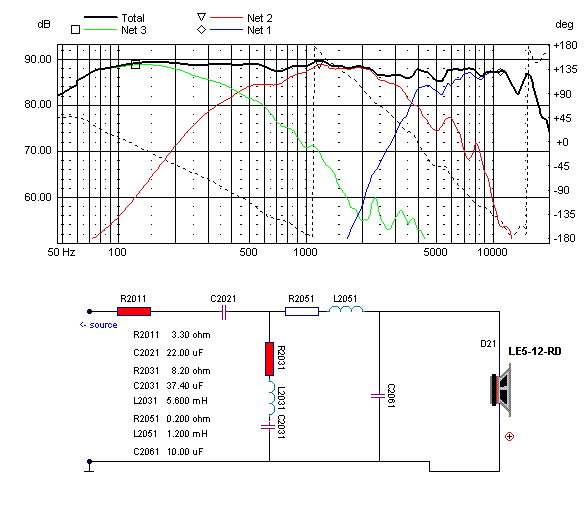
Seen above is the very
simple 2nd order crossover for the LE5-12-RD
middriver. There's not much we can do about the
peaks at 6 and 8 kHz but they don't appear to
ruin the treble response.
Whether the points of crossovers are going to be
450 Hz and 3.5 kHz is another question, but at
least this approach makes the troublesome LE5
suitable for a 3-way. And the good thing about
the LE5 drivers in general is that they are fast
as lightning. Very lightweight paper cones and
very strong motor systems.
Before we go to the crossover fine-tuning, let's
take a look at the cabinets.
|
The Cabinets
BACK TO TOP
Restoring these old cabs takes at least
the same time as making a new pair. Quite some work!
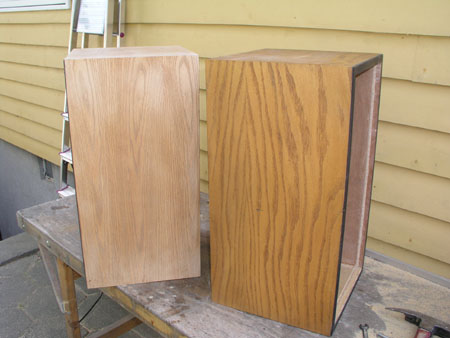 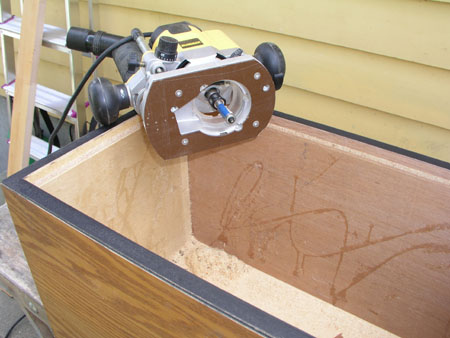
The old front panel was cut off by a jigsaw and the
remains removed with the router (router bit with a
wheel).
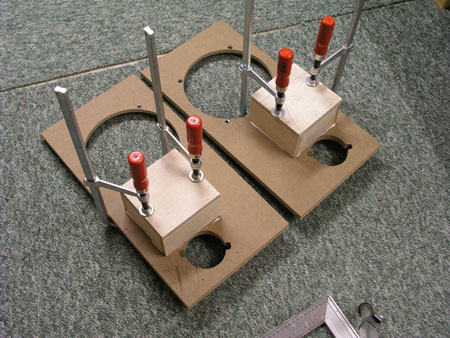 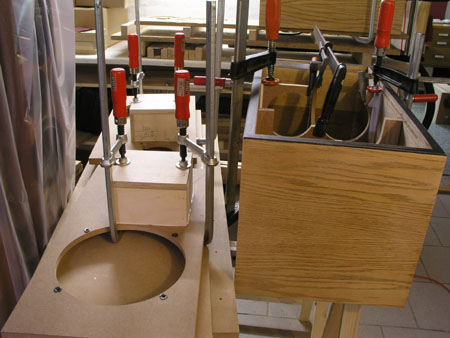
The middriver takes a cabinet and this one is 140 x 140 x
96 mm made from
12 mm side panels and 16 mm bottom panel producing 1.1
litre internal volume.
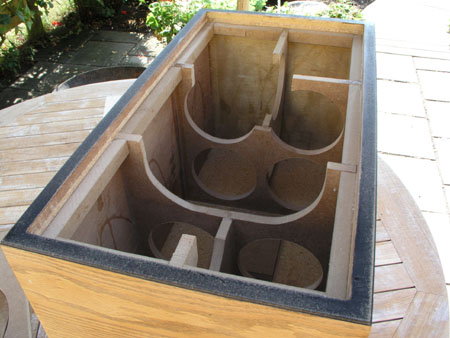 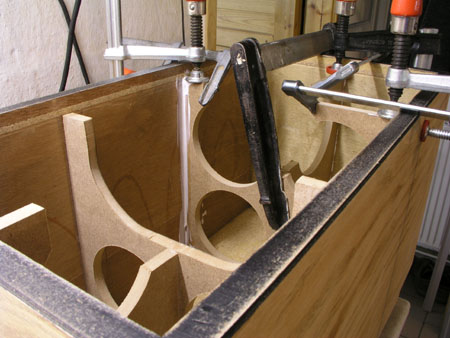
Bracing made from 12 mm MDF was added to the cabinet as
seen on the photos.
And I had to cut out for the mid enclosure. Fillets were
added to support the front panel.
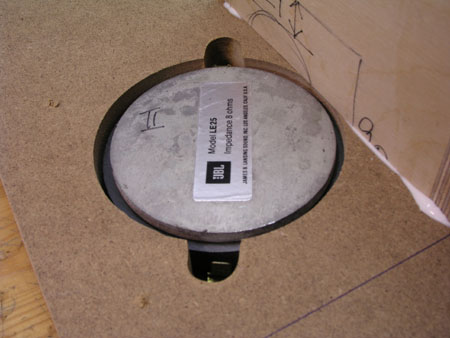 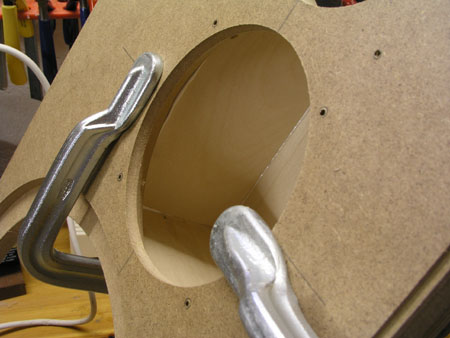
The LE25 cut-out needs "ears" for the terminals
and these are not 45 deg to the horizontal alignment. Put
the tweeter into the hole and mark the placement of the
terminals to route for the "ears". The
middriver really needs serious chamfering to allow free
air ventilation. Route 45° down to 5 mm from the front
as seen on the photo to the right. I can't stress the
importance of this enough. The LE5 mids have almost all
the ventilation to the sides and need a lot of chamfering
to breathe and not sound congested.
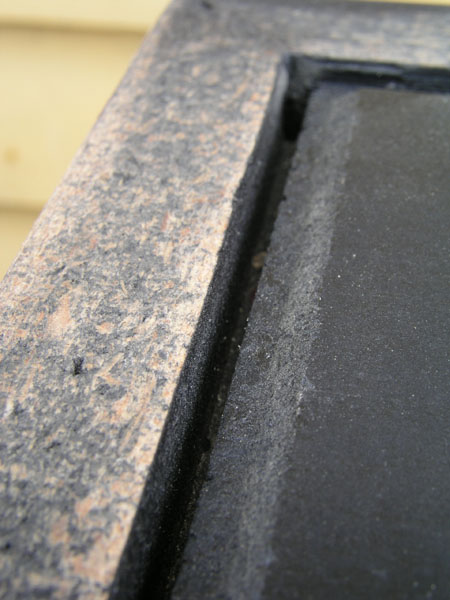 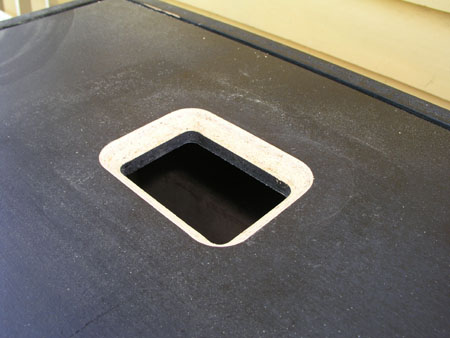
The rear panel is attached to the side panels by a notch
in a groove and can actually vibrate a lot. Loads of PVA
glue was added and I left it overnight to dry. The hole
for the terminals were chamfered as seen on the photo to
the right and a 19 mm MDF block was glued to the inside
for the new terminals.
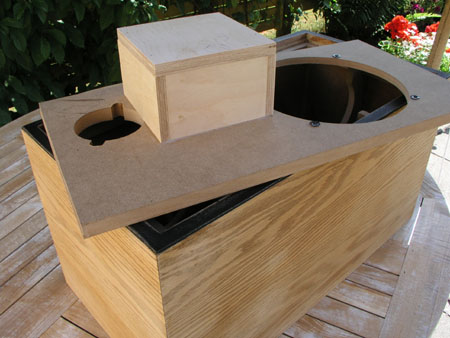 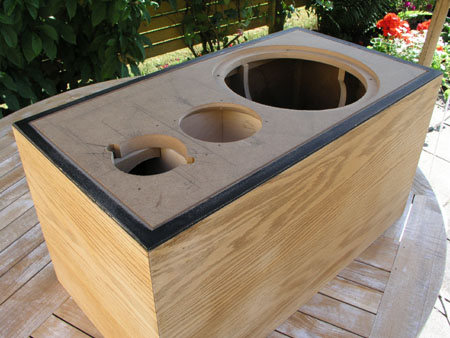
I like the original oak veneer and this was one reason
for keeping the olds cabs. Adding bracing and make the
best of it. The cabinet panels are made from chipboard
and I see chipboard coming back in a few constructions
(Living Voice). The veneer was sanded gently and is ready
for a new oil rub.
The vent?
You
may already have wondered where the vent has gone. Well,
the 125A bass driver has a high Qt and is really not
suited for bass reflex designs. So I've decided to try an
acoustic vent in this construction. These are available
from Scan-Speak and I'll add a single vent on the rear
panel behind the bass driver. If you want to know more
about an acoustic vent, I suggest you read the 2006
isssues of HiFiWorld where the Dynaco A25 has been
revived with the use of an acoustic vent. Usually an
acoustic vent provides a more amplifier friendly
impedance profile. We'll see how it performs.
If it doesn't work I can always remove the vent an route
a panel with a vent to be inserted in the rather large
hole that's needed for the acoustic vent.
Should you decide to stay with the vent, here are the
dimensions of the original:
Front panel driver layout and port
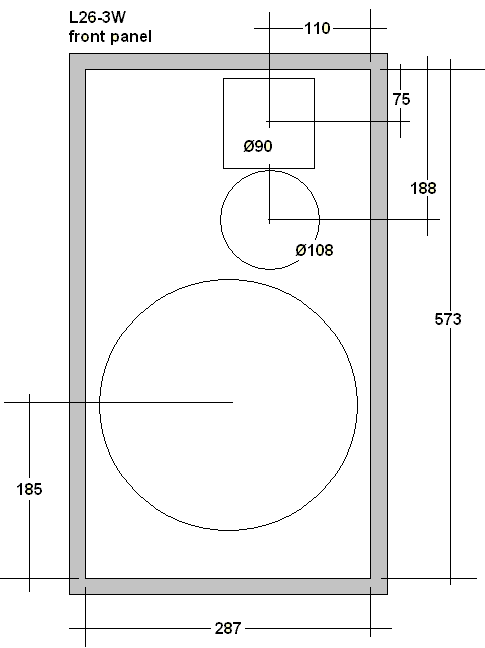

Left: As always: The
placement of the drivers have a major influence on the
response of the drivers
and I suggest you follow this layout to make the
crossover work properly. In particular this is
important for the middriver as seen above. The front
panel was made from 22 mm MDF.
Right: The JBL L26 vent
made from cardboard tube with an internal diameter of 68
mm..
The bent tube is very suitable for long vents. The cuts have to
be 90/4 = 22.5°
More pics from cabinet rebuild:
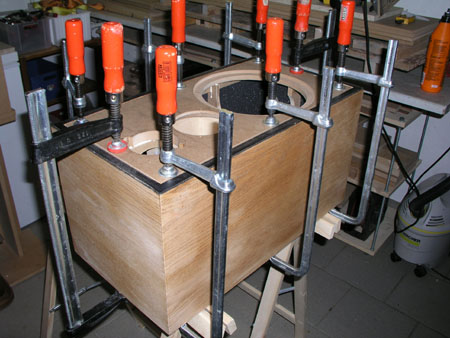 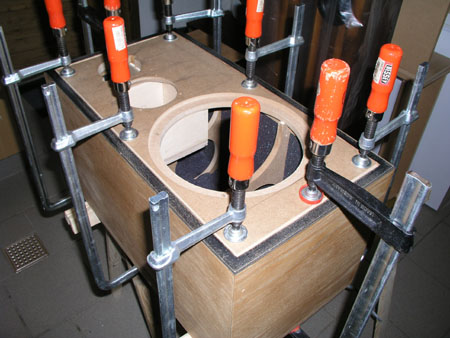
Gluing front panels in place.
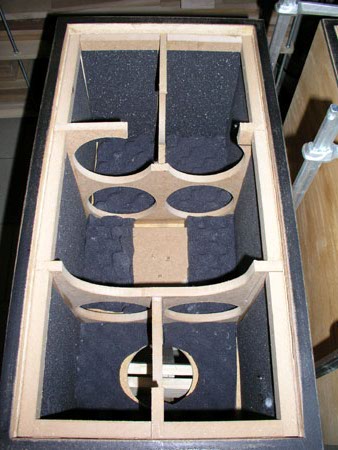 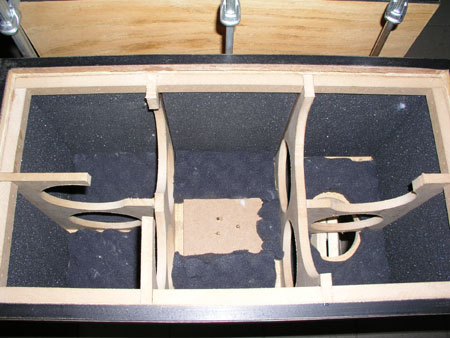
All internal panels except rear panel were added 10 mm
polyester foam.
Rear panel had 30 mm "wave" polyester.
Additional MDM3 poly/wool will be used for damping.
The crossover will be on small MDF blocks over the
terminals in the middle of the cabinet.
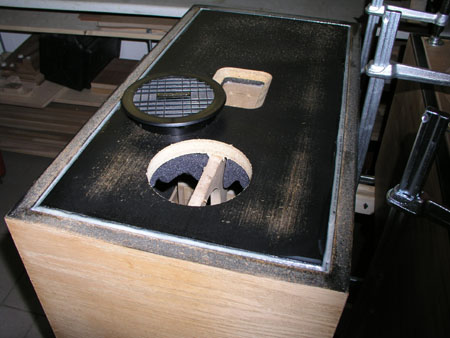 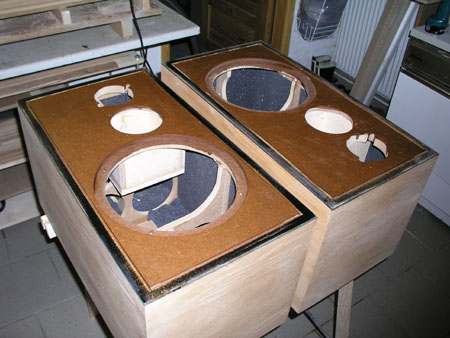
Rear routing for the acoustic vent. Right behind bass
driver. Centre 120 mm from bottom.
To the right: Front panels after adding laquer for
saturating the MDF to allow the use of water based paint.
The cabs were finished during the summer
holidays and the sanded veneer was given a fresh oil rub.
Front and rear panels had a dark grey colour and to put a
long story short, I'm very pleased with the result. And
it's very much time to finalise the crossover after a
couple of months' break. Gut feeling tells me the
800-3500 crossover option is the most likely to succeed.
Gut and gut.....a friend came by with a pair of JBL L100
Century speakers a month ago and I spend quite some hours
recording what they were doing. This will be reported
later, but what was apparent was the point of crossover
between bass and mid. The LE5 drivers really aren't meant
to go very low due to high Fs and much of the JBL sound
is derived from the bass handling lower and middle
midrange. The LE5s are more like mid-treble hybrids and
should be treated accordingly.
Due to the bracing, the cabs appear non-resonant and I
can't wait to hear how the drivers will perform under
these new circumstances.
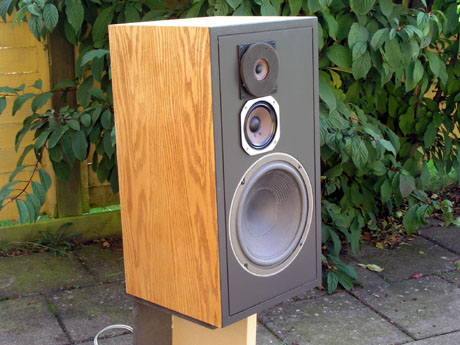 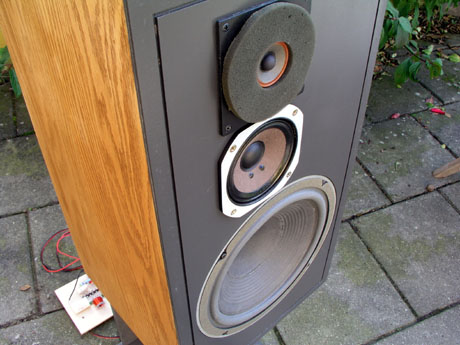
Crossover:
BACK TO TOP
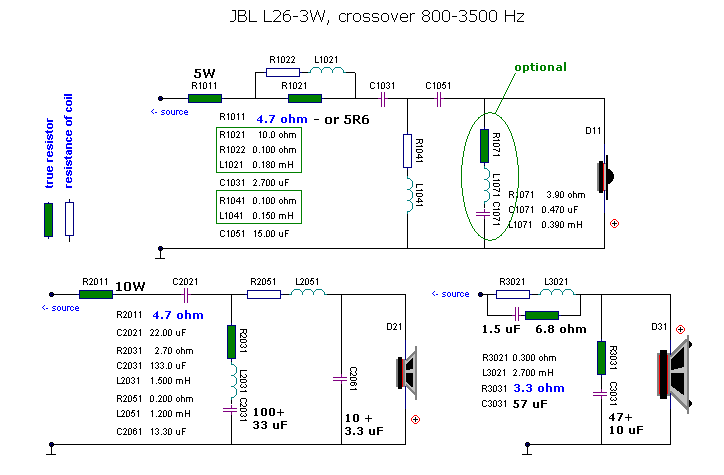
Measurements
BACK TO TOP
.jpg) 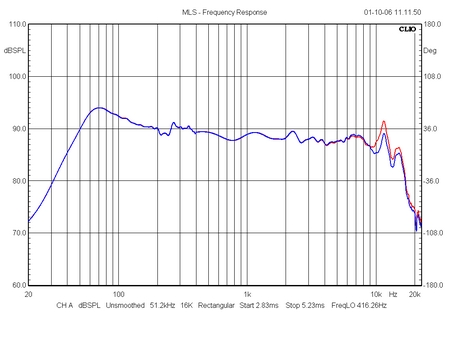
Left: In all of the
midrange and up to 10 kHz a smooth response is achieved
and minimum phase tells it all seems to work fine.
Right: SPL including
merged nearfield reading of bass response. Disregards the
200-300 Hz region - all things can be achieved when doing
nearfield measurements at 1 mm distance to the cone.
Blue in including the tweeter notch filter.
.jpg) .jpg)
Left: Mid, tweeter and
summed response. Green = reverse polarity of tweeter
displaying nice phase tracking between the two drivers.
Right: Inpact on
frequency response of RC circuit bypassing bass series
coil. It's impotant that the huge 2-3 kHz peak from the
bass drivers is reduced.
.jpg)
Impedance of system. An overall easy load on the
amplifier.
That JBL sound!
Connecting the first speaker
from the test crossover set-up, my first reaction was:
Well, I'll be damned - or something similar in Danish. My
surprise was due to the treble. My expectations from the
LE25 tweeter had been so and so. This tweeter is much
better than measured performance would suggest. Sibilance
is handled gracefully and there's an overall ease in
presentation. Hmm... a large, rigid paper cone... It
takes a minor equalisation to get the balance right and
there's not much we can do about the 12 kHz not
ch -
except for lowering the response in the 10-15 kHz range a
little. You can increase tweeter level by 1-2 dB and yes,
there's too much treble, but it doesn't become bothersome
in the way most dome tweeters do. Strange. Does this
tweeter really have such low distortion? Whatever it
does, it points to the fact that we should take great
care with what a tweeter does at 3-10 kHz and what's
beyond may be less interesting. Oh yes, the 10-20 kHz
provides the airiness to the overall sound, but whether
it has to be ruler flat is a good question. Supertweeters? Honestly, forget about supertweeters and
let's talk about the things that matter.
My most troublesome,
sibilant female vocal recordings? Probably the best
speakers I've had with regard to this particular problem.
Disturbing!
Having both speakers running, some further mid and
tweeter attenuation adjustments were done, but nothing
suggested a second round of crossover tweaking necessary.
Mid attenuation may be further improved, currently
running from a 4R7 series resistor giving a flat upper
midrange with lots of detail. The LE5 mid appear well
tamed and it's presenting upper mid and lower treble with
delicacy. Not without some JBL colouration, but this was
expected.
This speaker can play loud,
really loud. Almost as loud as the old SEAS 503 kit - with it's
13" bass driver. There's nothing like a big bass
driver! Due to the acoustic vent, the bass is firm, solid
and up in level all the way down to 50 Hz, from where it
starts rolling off.
Initially I played the speakers from a 6W SET amp, and at
average listening level everything went well - actually
with an amazing level of transparency. Cranking up the
volume, the poor SET started clipping. No wonder, the
JBL-3W may have 89-90 dB sensitivity, but it can handle a
lot of power. The 50 wpc Copland power amp was a more
adequate driver and with an old 250 wpc Parasound power
amp the bass became even more rock solid. You need a
decent amplifier for these speakers, not because of
inefficiency, but because you can't help playing them
loud.
Detailed descriptions of sound
is boring and I'll stop here. If you love that JBL sound
and want to hear what a modern filter can do to the JBL
sound, you may try what's been described here. It's some
journey and some of the effort going into such a project
has to come from the satisfaction of restoring vintage
equipment. I'm certain some of the JBL drivers hold
qualities worth the effort and the end product can easily
compete with modern equipment if not sometimes leave it
way behind.
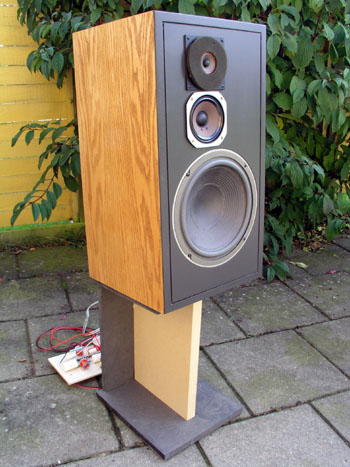 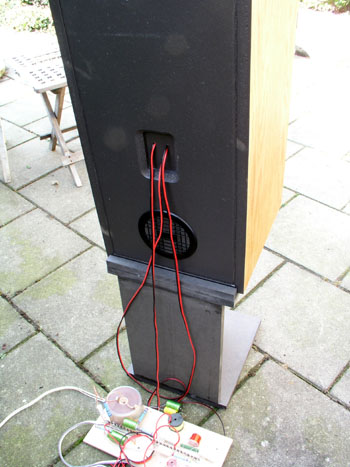
Crossover
Components
BACK TO TOP
Discontinued as kit from
Jantzen Audio. Buy components locally.
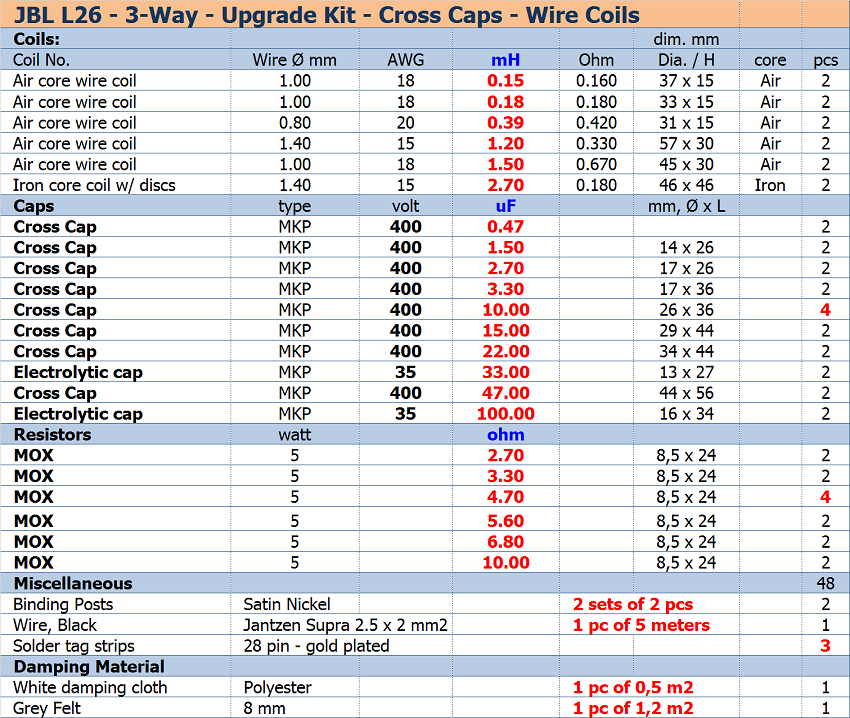
All technical questions to me at
troels.gravesen@hotmail.com
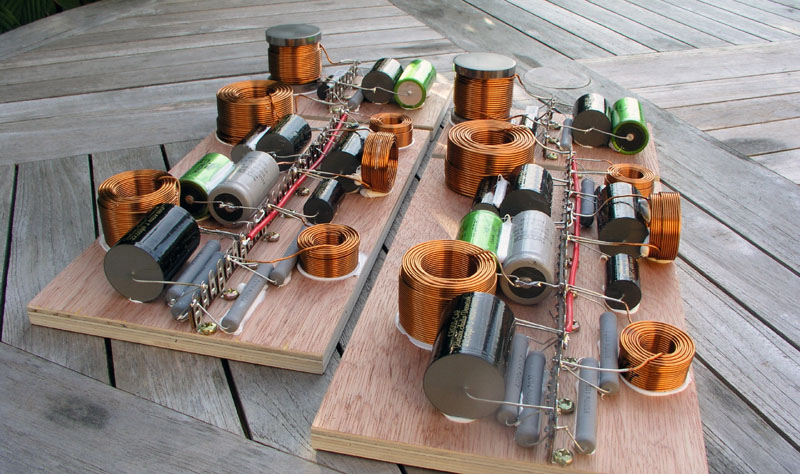
All crossover boards.
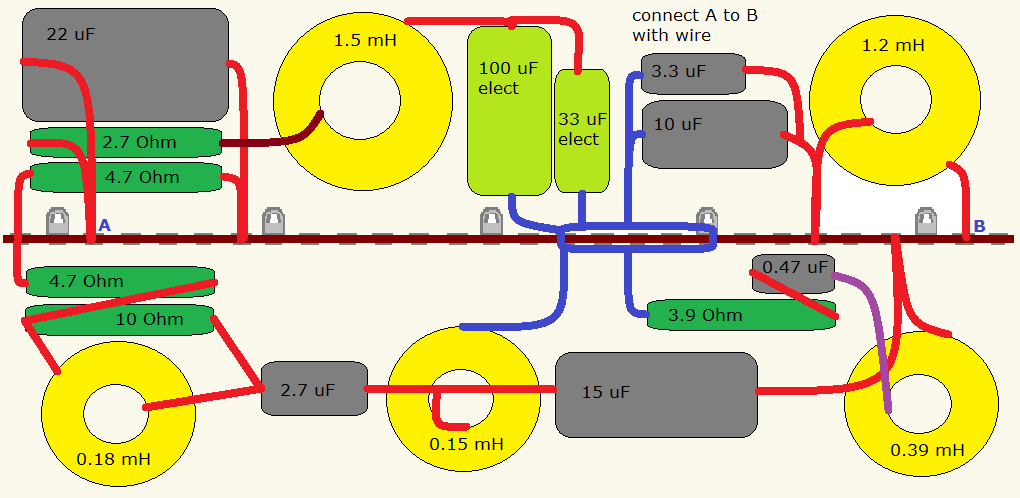
Mid-tweeter section layout.
Remember both
midrange and tweeter connected with inverted polarity.
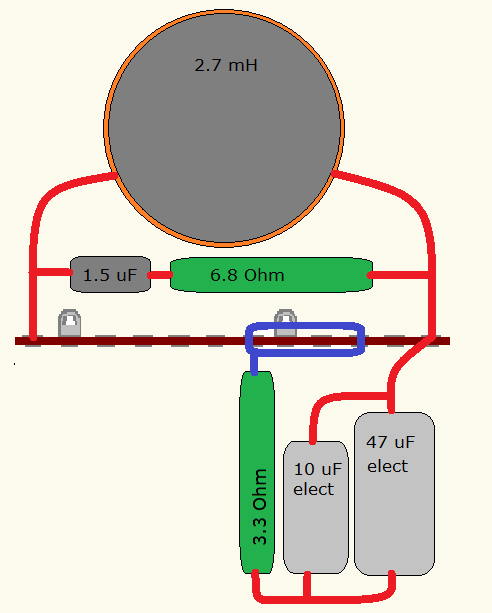
Bass section layout
Speaker wiring
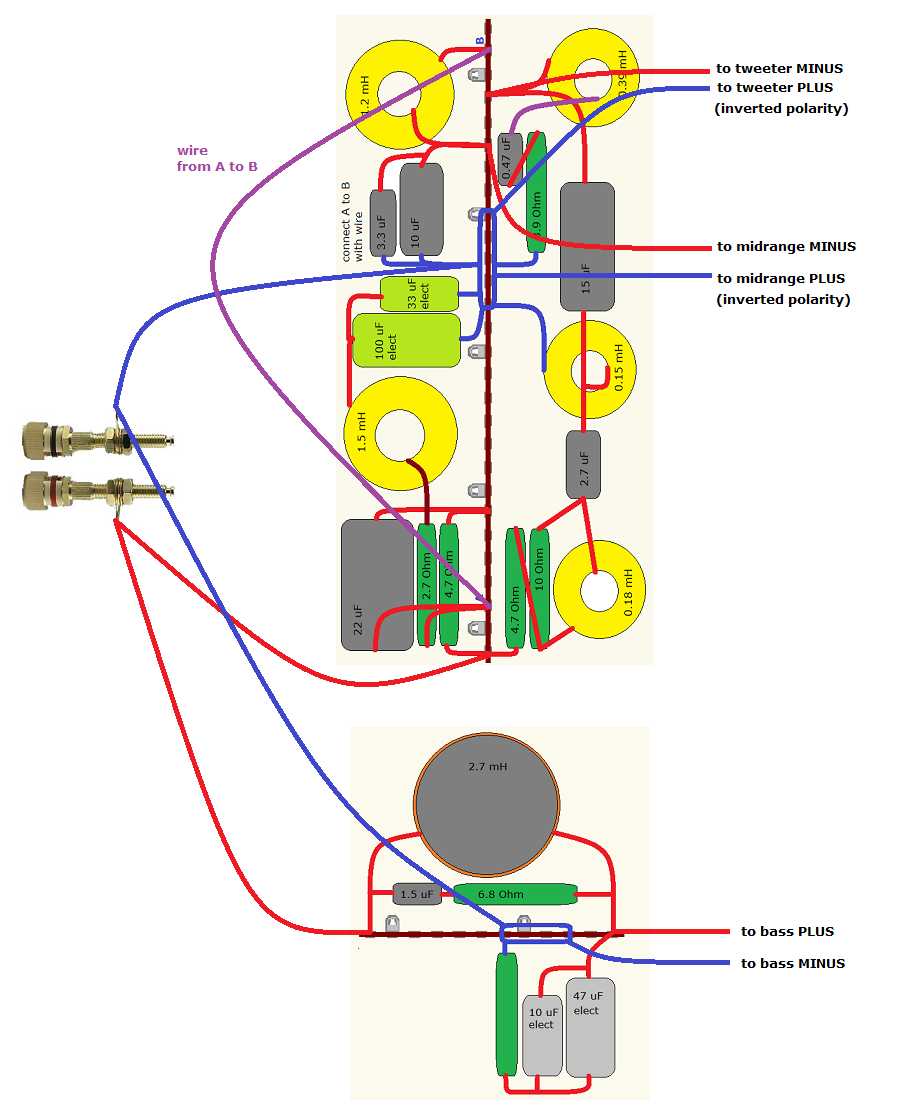
Use this to find polarity of your drivers:
http://www.troelsgravesen.dk/polarity.htm
BACK TO TOP
|
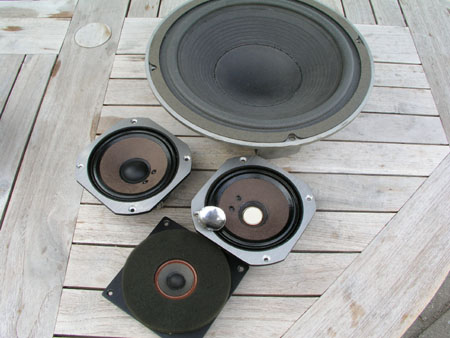
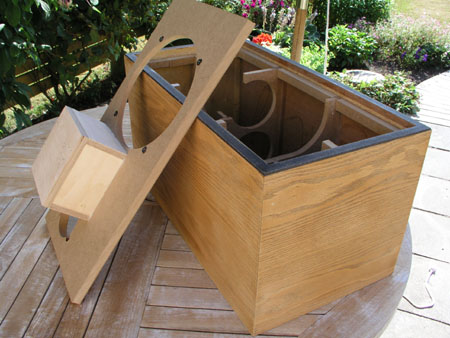






























.jpg)

.jpg)
.jpg)
.jpg)






